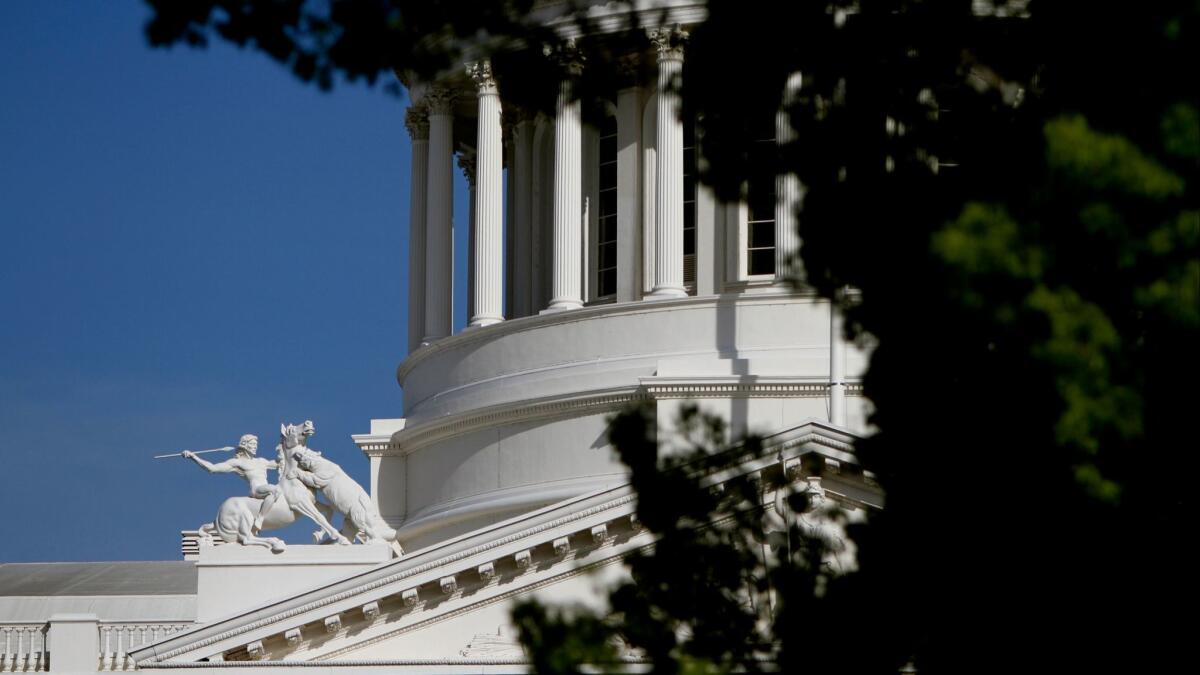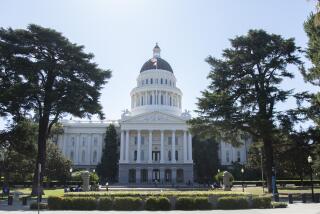California lawmakers consider a $543-million change to the state Capitol in Sacramento

- Share via
Reporting from Sacramento — Once seen as a modern marvel that enhanced the original 19th century landmark in California’s capital city, the state Capitol’s 66-year-old annex was declared by architects and lawmakers on Wednesday to be long overdue for demolition and replacement.
“There’s many ways in which the building is not welcoming to all Californians,” said Assemblyman Ken Cooley (D-Rancho Cordova), the legislator leading the effort.
On Wednesday, the Joint Rules Committee of the California Legislature embraced a $543-million proposal to build a new addition to the original Capitol building, providing ample meeting space for lawmakers and their constituents, and built with a focus on the safety and security needs of employees and visitors.
“I think we owe it to them to provide an annex that is accommodating to all folks,” state Sen. Anthony Cannella (R-Ceres) said.
The three-year project, which has not yet been approved by state officials, would completely remove and replace the building that was attached to the original Capitol in 1952. That building was symbolic of the state’s boom times of the mid-20th century, quickly becoming a key part of the governing process as legislative sessions were extended into a year-round operation.
“Even the elevators will have class,” said an article published in the Los Angeles Times on Sept. 11, 1950, about the annex building then under construction. The article went on to peg the total construction cost at $7.25 million.
Column: Some say it’s time for a larger California Legislature »
Today, however, the unadorned building housing almost all legislator staff offices, the governor’s private suite of offices and large committee meeting rooms has become a frequent point of criticism. Much of the building lacks a sprinkler system in the event of a fire. Several of its narrow hallways and rooms aren’t fully compliant with the Americans With Disabilities Act. A parking garage for lawmakers directly under the building has raised security concerns. There are continual complaints about temperature, plumbing and wiring.
And as school groups and activists would attest, the 1952 addition was never properly aligned with the historic Capitol completed in 1864 — a visitor looking for a second-floor office on one side of the building may wonder why access is through the third floor on the other side.
“I get confused with navigating this building,” Cannella said during Wednesday’s committee briefing.
The plan as currently drafted includes a new visitor’s center, as well as a relocated lawmaker parking facility. A key unanswered question is where the Legislature would be moved in the roughly three-year construction phase, a daunting task given the wide array of services that would be needed in an alternate location in Sacramento.
Gov. Jerry Brown raised the question of what to do about the existing Capitol annex in his 2016 state budget proposal. But while a spokesperson for the state Department of General Services agreed on Wednesday that the building is inadequate to serve current needs, the $543-million proposal has yet to be embraced by Brown. The expectation is that the cost would be paid for out of the state’s general fund, and lawmakers have pointed out that the Capitol project seems to fit the bill for using recent tax revenue windfalls on one-time expenses instead of ongoing programs.
Cooley, who was once a legislative staffer and is considered one of the Capitol’s honorary historians, noted that Brown was also governor during the seven-year renovation of the historic Capitol that was completed in 1982. He and other officials toured other statehouses across the nation in search of ideas on how to improve the aging seat of government in Sacramento.
“Many states are ahead of us on this curve,” he said.
Follow @johnmyers on Twitter, sign up for our daily Essential Politics newsletter and listen to the weekly California Politics Podcast.
More to Read
Get the L.A. Times Politics newsletter
Deeply reported insights into legislation, politics and policy from Sacramento, Washington and beyond. In your inbox three times per week.
You may occasionally receive promotional content from the Los Angeles Times.











